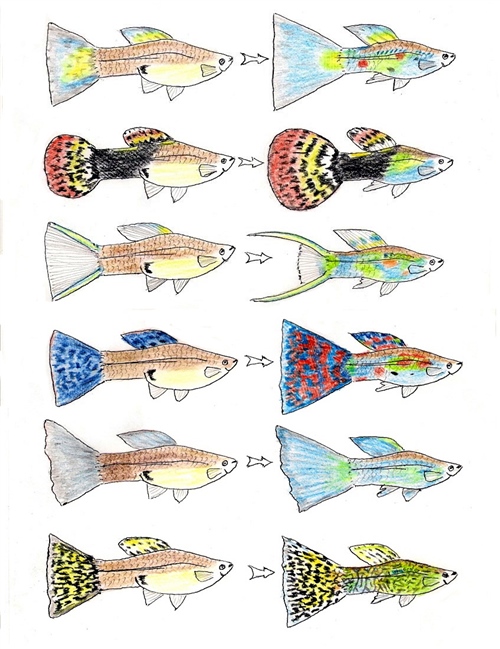Art XII
How to make use of the Genetics to breed beautiful Guppies (3)
RUBRIEK: Guppy Kweek English Translation
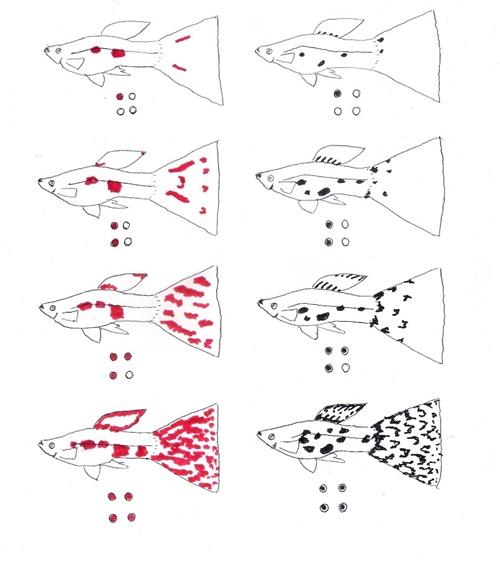


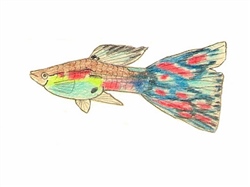
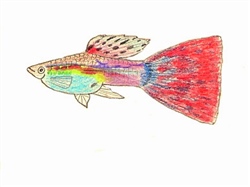
Now let us transpose everything we have seen to a more practical way of application. Let us no longer represent the genes by symbols , but by graphical balls: a red ball for a gene for red color, for example; and a ball with a black center for spots instead of Vl or Sp (spots). After all, this works visually immediately. We have seen that genes have a qualitative content, which relates to the specific characteristic that they geneticly generate. But also that they have a quantitative aspect: the more genes an individual has for a certain trait, the more accumulatively this will be emphasized. Three genes for Red give more red than just one. And with the locations , a third aspect is added: the characteristic is filled in progressively for the preferred locations of this characteristic. In the above example, it can be seen that in the presence of only one gene, both the color red and the spots are "put" on the primary preferred sites (which are different from each other for red and spots). And with an amplification of genes, the trait expands across the secondary preferred sites, then across the tertiary, and so on. And THIS gradual process, one can recognize in its combinations shown by living guppies (see drawings of the guppies I have had in the table on the left).
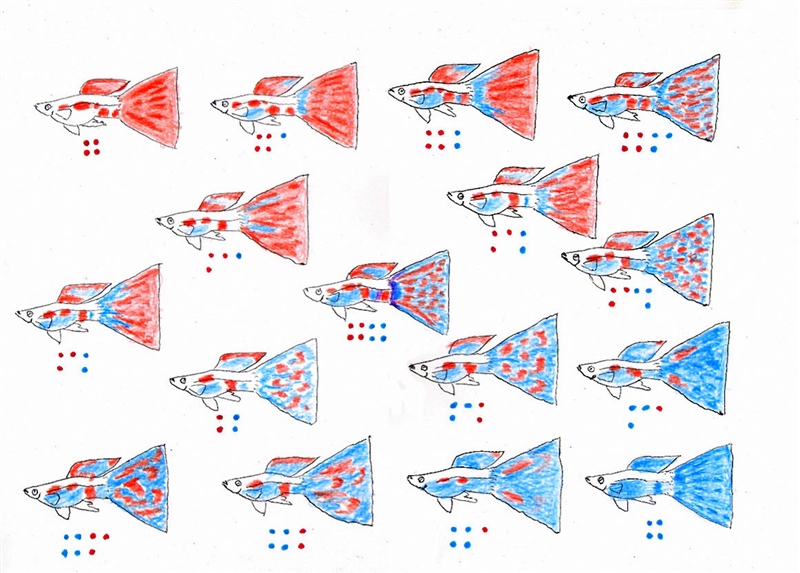
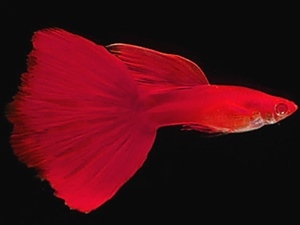
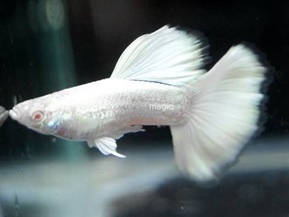
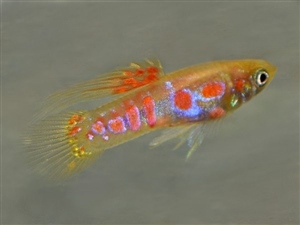

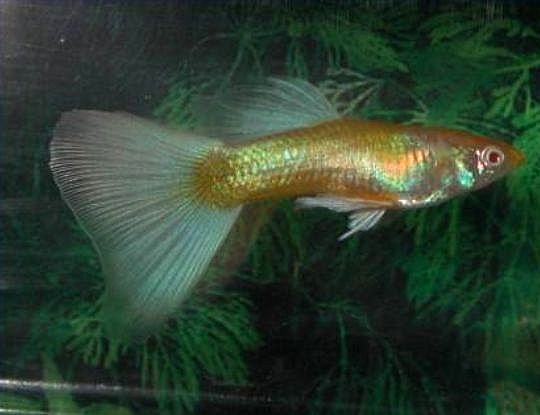
What this gives in practice for 8 possible aleles for 2 colors, I have worked out in the drawing above. This gives a total of 15 possible combinations with a different occupation of blue and red from zero to 4. For the fun I drew one double; as a quiz you can try to get that combination out. Now that's an example for just two colors; you may have noticed that for most combinations the total 8 gene sites are not occupied. This happens, for example, through the intervention of a third color - possibly green. Because there are a lot more colors are involved in the pallet of the gup, these color locations are covered by at least 13 allele pairs.
Therefore one can understand that many guppy breeders go for domi-nant patterns, where the variability is much smaller, and the number of combinations is limited. Another way is to breed mono-chrone fish: single color guppy (red gup, blue gup, black gup, green gup, white gup, .....) . This often results in fish dripping, as it were, from "dyes", such as a wall on which one has painted too thick a layer of paint. And may it deserve a medal for patience and perseverance, such one-colored guppies always violate the richness of color of the species.
Still other growers solve this in reverse: by growing recessive strains in which at least one layer of the various cover layers has been stripped. Eliminate the black of the melanin by breeding blonde or albino guppies, and you get a smooth background against which especially red and yellow colors stand out very nicely. For example, compare a blonde ginga rubra with a regular gray one, and you can ascertain its effect noticeably. One also gets a kind of "depth effect". The imperfections in the color pattern, on the other hand, will be toned down so much in an albino that they are reduced to an inconspicuous hue or shade.
All of these recessive homozygotes also have a problem side. By the way, this is the main problem in guppy culture: the urge to get a strain as pure as possible or homozygous in one color or trait, greatly limits the gene potential. In the wild, the REVERSE effect occurs: mixing or hybridiza-tion prevents homozygotism . This potentially keeps the geniuses up and the population healthy. Because as I mentioned, genes work together and homozygotism can go hand in hand with concentrating "harmful" genes in this inbreeding, or with the loss of essential traits (vitality, speed, resilien-ce, defense parasites and diseases, .....) . Purebreds are always more vulne-rable and weaker than "bastards". Therefore, "new blood" will always have to be introduced into the breeding lines to counteract this deterioration in vitality. But this will result in a certain decline in the breeding goal.
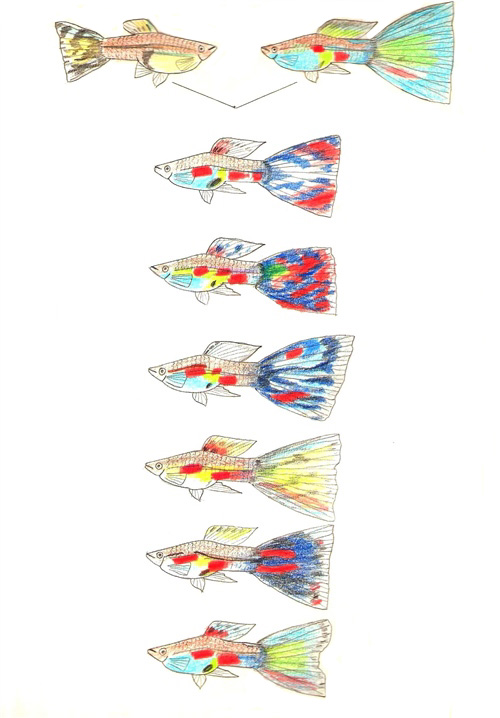
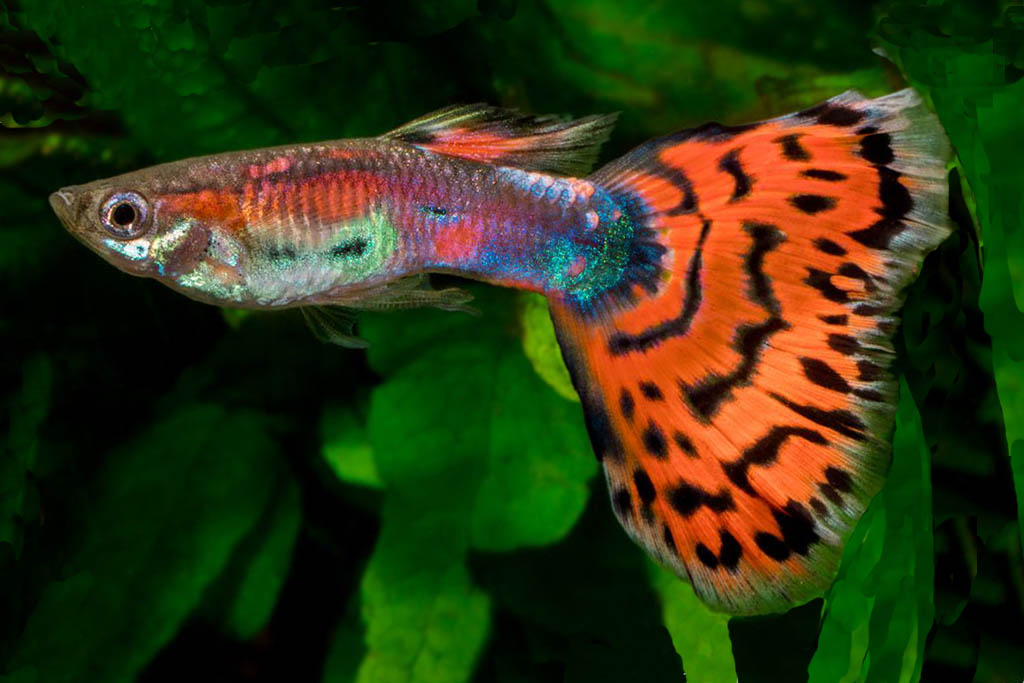
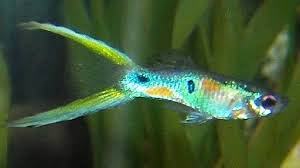
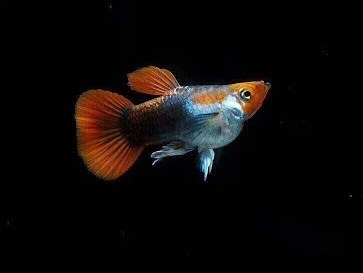
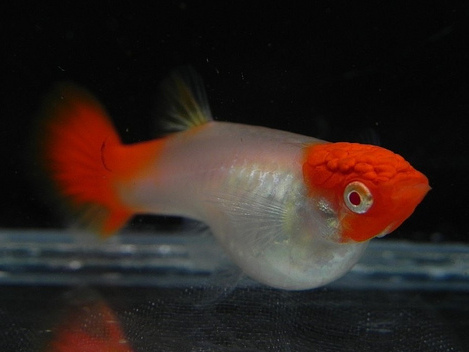
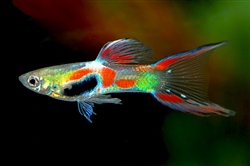
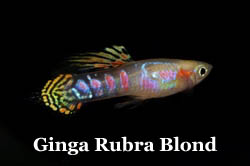
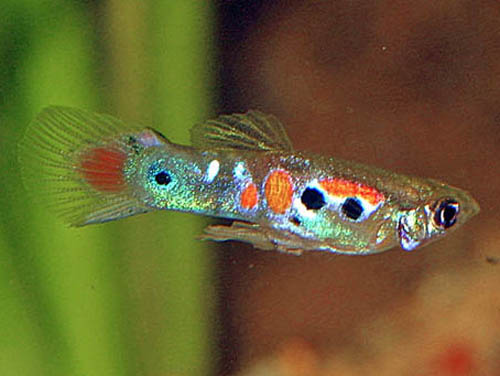
What can happen when two strains are crossed, the pictures above and below give an example. Above is a cross between a male blue triangle, with a female of a blue-red breeding line. It results in a whole series of hybrids that are different from each other, displaying traits from one strain as well as from the other. In contrast to the F1 of an older pair that only differs in 1 allele pair, in this reality we get a hybridization that runs over several (minimum 13) allele pairs. Since the female also did not have a true symmetrically developed tail fin, we also get males and females in F1 with different degrees of triangle fin tails.
This is certainly the case in the cross between a blue-green lyre tail and a blue-red triangle female below. Although this female does have a beautiful and regularly developed tail fin, the offspring here also show all kinds of intermediate tail shapes between incomplete double swords, triangles with a notch in the middle, up to and including bottom swords. This process is called regression , and it is something that is seen again and again with fancy guppies that are released back into the wild: a regression or relapse to the wild form. The females will also show loss of patches of color from their tail fin. For guppyclubs where the perfection of the tail shapes is the holy grail of judging and are one of the basic foundations of a strain, this is a straight catastrophe. But for guppy lovers like me, who favor a gup in a more natural phenotype and a more varied genotype, those freaks with full-grown fins, squashed bodies, koi-like growths on the snout, or super-one-sided homozygotes, are the real catastrophes (see left).
At the turn of the century, there has been a renewed interest in the original gup with a natural color palette of various colors. A come-back that starts with the endler , continues in crossings between endlers and guppies, flares up with the gingas , and eventually ends in an increasing interest in the wild catch at the places of origin, or for released populations in places where the guppy did not previously occur.

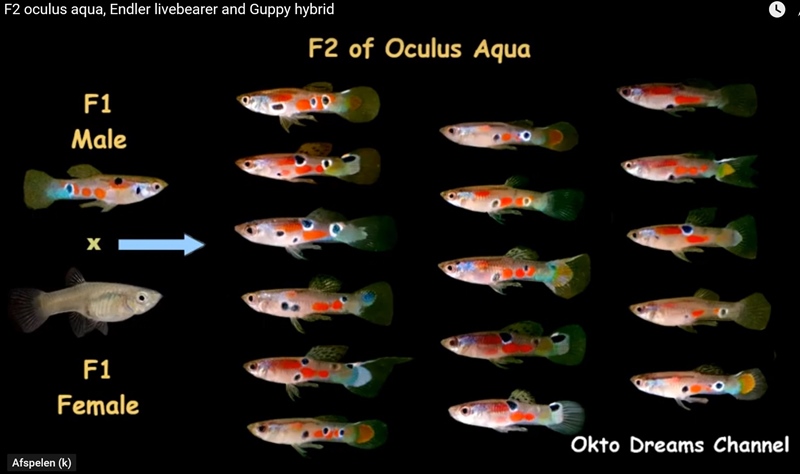
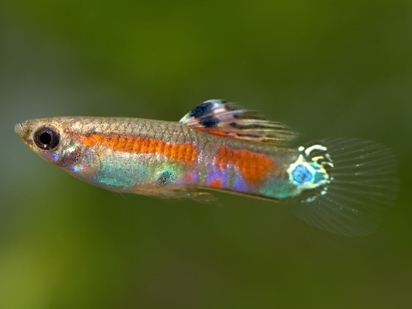
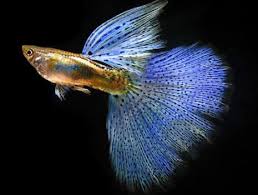

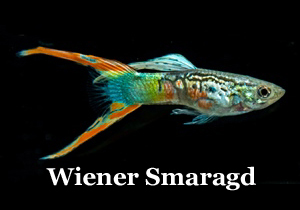
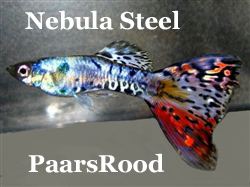

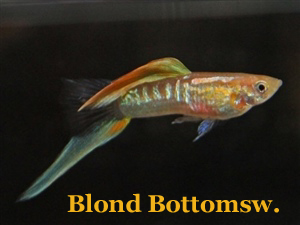

Therefore this advice: if you prefer safety, choose the certainty to grow within the standards of a certain strain. You will no longer find novelties there, because the fact that people are now following the path of freaks to be able to come up with a "novelty", proves that they have completely explored all the genetic corners of the gup. Growing even larger fins is no longer an option either, because the limit has also been reached there . Fins should enable a fish to swim, and certainly should not prevent it. What remains then is to grow a gup in a new color combination. Not necessarily one that has not yet been seen, but one that YOU love.
If you want to look forward with pleasure and expectation to "what is to come" instead of working towards a certain "goal", choose the experiment . And then, for example, cross an endler with a gup, looking for beautiful color combinations or drawings. But be aware at the same time that you should keep the integrity of both the endler and the gup intact. Making it a genetical melting pot with fish that appear to consist of pieces glued together - as it happened with the poecilia reticulata itself - is out of the question. Take as an example the gingas or the tigris' which mean an enrichment. I enjoy the sober design of the videos of "Okto Dreams Channel": only a filter sound as background and beautiful figures on a black background (see photo above).
If you really want to grow guppies , preferably use strains that allow a good portion of variability in pattern and color as there are: Vienne Emerald (also called Wienner Emerald); Nebula Steel , Galaxy and the Snakeskin (also known as King Cobra) who are "cousins" to one another; without forgetting the "regular" multi-color Double Sword and Bottom Sword .
Never forget that in order to get a nice breeding, one must be with two . And I do not mean by this "the breeder and the guppy", but males AND females . Sometimes pne marvels too much the males because they are the ones who show all those colors and patterns ; but females are equally important for breeding. At the time I composed my own colors by choosing females from various shops and strains. Because for understandable reason gup males and gup females don't sit together, which often results in the females all sitting together in one tank by lack of space. And although I know that many guppy breeders will declare that the "view" cannot be relied on, because the phenoytpe can be deceived and many recessive genetic factors can be masked, I rather wil argue for trust in good observa-tion, rather than for mistrust. Because this masking mainly applies to the different types of coatings; in terms of colors and patterns, the inter-mediate is much more common than the dominant. And true sex-related inheritance is also rarer than "sexual equality" - we live in modern times! - so that the females also physically show the characteristics of their geno-type. Only, it takes a little practice to recognize and "extrapolate" it. Perhaps the table below can help you get started in that.
